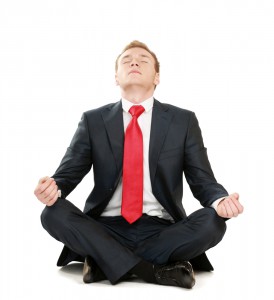 Mindfulness meditation, at first glance, provokes a reasonable question: “why on earth would I, or anyone for that matter, sit still doing nothing for long periods of time?” And we can take two basic approaches to answering this question: we sit still for long periods of time in order to reap a lot of benefits — to get a return on our investment — an ROI.
Mindfulness meditation, at first glance, provokes a reasonable question: “why on earth would I, or anyone for that matter, sit still doing nothing for long periods of time?” And we can take two basic approaches to answering this question: we sit still for long periods of time in order to reap a lot of benefits — to get a return on our investment — an ROI.
Or we sit still for long periods of time in order to achieve nothing.
Let’s take the ROI approach first. Recent scientific research seems to document that mindfulness meditation produces a wide range of positive results: strengthened immune systems, enhanced emotional and physical health, reduced anxiety and stress, improved sleep patterns, and much more. At work, some research suggests that mindfulness can significantly increase the quality of awareness and emotional intelligence we bring to our jobs. And the Buddhist tradition speaks of the possibility of “enlightenment” — a final and ultimate human realization marked by vast wisdom, compassion, and joy. So, when we take an ROI approach to meditation we look for a return on our “sitting-still-for-long-periods-of-time” investment where we run the possibility of achieving a healthier, less anxious, and more “enlightened” version of ourselves.
The other approach to understanding why we would sit still for long periods of time is that we are learning not to achieve but how to be. Such a notion may appear a bit odd to some, maybe even offensive to others. “Wow, I’m learning to just be. . . all you other guys get to work achieving stuff while I learn how to be!” But this approach to mindfulness meditation — traditionally called perfecting the wisdom of non-achievement — is not about some hippie notion of taking a spiritual vacation from reality. Rather, such an approach is about perfecting a very simple yet demanding gesture: fearlessly opening to whatever occurs.
From this perspective, when we sit still for long periods of time, we shed our need for an ROI and instead seek to engage exactly who and what we are — to explore our experience honestly and to touch our lives directly — which requires courage, gentleness, and poise. When our ambition shifts from becoming someone else — someone less confused, more enlightened or less stressed out — to being exactly who we are, we exercise an entirely different set of spiritual muscles. Rather than achieving, we are discovering; rather than accomplishing, we are recognizing; rather than mastering, we are expressing.
In business, getting a return on our investment of time, money, and resources is . . . well, what business is all about. But when we blend mindfulness meditation with making a living we discover that pursuing an ROI is a mere part of a much larger landscape. When we exclusively focus on pursuing goals, hitting targets, completing projects, and meeting expectations, our ambition, while worthy, can nonetheless blind us with its speed and forward looking intent. And it is here where mindfulness meditation and the wisdom of non-achievement can make all the difference in the world. Because in our haste and speed to achieve, we may in fact be speeding past the very thing we are looking for. Such speed can obscure solutions hiding in plain sight, camouflage potential business partners as adversaries and blind us to creative possibilities of all kinds.
In this sense, sitting still for long periods of time is how we slow down, wake up, and reacquaint ourselves with seeing and living our lives clearly. Whether on the job, at home, or at the local grocery store, mindfulness meditation encourages us to fearlessly open up to life on its terms rather than ours, to step past our fixation on making life “better”, “happier”, or “more secure” and instead confidently recognize and embrace life for exactly what it is.
And as Shunryu Suzuki Roshi, the famed Zen Master, so wisely instructed concerning how to practice mindfulness meditation: “Try not to achieve anything special. You already have everything in your own pure quality. If you understand this ultimate fact, there is no fear.”
Michael Carroll, author of Fearless at Work, worked on Wall Street and in the publishing industry for over two decades, holding executive positions at Shearson Lehman Brothers, Paine Webber, Simon & Schuster, and the Walt Disney Company. Founding director of AAW Associates, Carroll consults with major corporations on bringing mindfulness into the workplace. He is a longtime student of Buddhist meditation and an authorized teacher in the lineage of Chögyam Trungpa. Carroll has taught mindfulness meditation at the Wharton School of Business, Columbia University, Kripalu, and the Cape Cod Institute.
For more information please visit http://www.awakeatwork.net, and follow the author on Facebook and Twitter.
Image credit:Shutterstock.com



